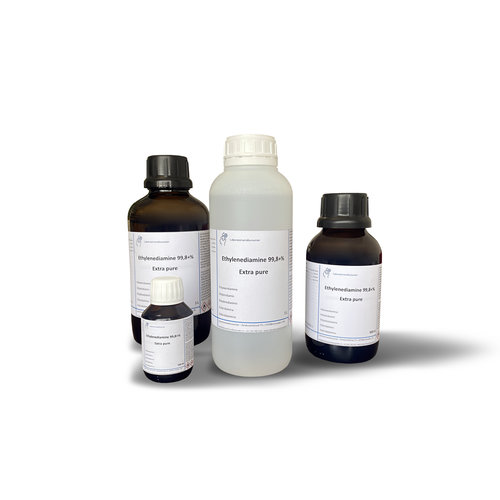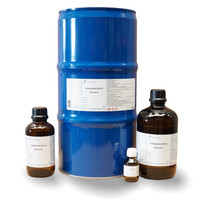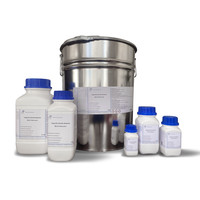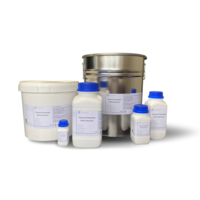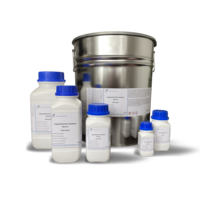You have no items in your shopping cart
Ethylenediamine 99.8 +% Extra pure
- Buy 2 and save 5%
- Buy 6 and save 10%
Ethylenediamine, ethane-1,2-diamine, often abbreviated as EDA, is an organic chemical compound from the group of aliphatic primary amines. More precisely, it is a diamine.
characteristics
-Physical Characteristics
Ethylene diamine has a relative gas density of 2.07 (density ratio to dry air at the same temperature and pressure) and a relative density of the vapor-air mixture of 1.01 (density ratio to dry air at 20 ° C and normal pressure). The density is 0.90 g cm-3 at 20 ° C. Ethylenediamine also has a vapor pressure of 12.4 hPa at 20 ° C, 22.6 hPa at 30 ° C, 39.4 hPa at 40 ° C and 66, 3 hPa at 50 ° C
-Chemical properties
Ethylenediamine is a flammable liquid belonging to the group of aliphatic primary amines. It is completely miscible with water to form a hydrate. The aqueous solutions of ethylenediamine have a strong basic reaction. In addition, Ethylenediamine is hygroscopic and smokes in moist air. Ethylenediamine is considered to be of medium to low volatility. An aqueous solution with a concentration of 100 g l - 1 has a pH value of 12.2 at 25 ° C.
Use
In complex chemistry, ethylenediamine is mainly used for the synthesis of chelating agents (eg ethylenediaminetetraacetic acid). It is also used as a solvent, stabilizer and for acid neutralization in oils. It is also used in the manufacture of synthetic resins, rubber chemicals, pharmaceuticals, pesticides, inhibitors, and detergents and cleaning products. In organic chemistry, ethylenediamine is also used as a basis for the isomerization of allylic alcohols to aldehydes, for the reduction of nitroarenes to azo compounds and many other reactions. It is also used as an intermediate in the fields of corrosion protection, polyamide resins and lubricants and fuel additives.
Safety instructions
Ethylene diamine vapors can form explosive mixtures with air when heated above flash point. Ethylenediamine is mainly absorbed through the respiratory tract and skin. This leads to acute irritant effects on the skin and mucous membranes up to and including chemical burns. Ethylenediamine also has strong effects on the blood, kidneys and cardiovascular system of the affected person. Chronic ingestion or absorption can lead to respiratory irritation and asthma disorders, the course of which is often unknown. In addition, irritating and allergic skin diseases can develop. Animal experiments have shown an influence on liver and kidney function. Reproductive toxicity, mutagenicity or carcinogenicity have not yet been demonstrated. Ethylenediamine has a lower explosion limit of about 2.5% by volume and an upper explosion limit of about 16.3% by volume. The ignition temperature is around 400 ° C. The substance therefore falls into temperature class T2 and explosion group IIA. The maximum gap width was determined to be 1.25 mm. With a flash point of 34 ° C, ethylenediamine is considered flammable
Technical information
mpirical formula C2H8N2
Molar mass (M) 60.10 g / mol
Density 0.90
Boiling point (bp) 116 ° C
Flash point (flp) 38 ° C • Melting point (mp) 11 ° C
ADR 8 (3) II • WGK 2
CAS No. [107-15-3]
EC no. 203-468-6 • UN No. 1604
$$$$$
Hazard statements
H226 Flammable liquid and vapor
H302 + H332 Harmful if swallowed and if inhaled
H311 Toxic in contact with skin
H314 Causes severe burns and eye damage
H317 May cause an allergic skin reaction
H334 May cause allergy or asthma symptoms or breathing difficulties if inhaled
cause
H412 Harmful to aquatic life with long lasting effects
Safety recommendations
Precautions - prevention
P210 Keep away from heat, hot surfaces, sparks, open flames and other ignition sources. Do not smoke.
P280 Wear protective gloves / protective clothing / eye protection / face protection.
Precautions - response
P303 + P361 + P353 IF ON SKIN (or hair): Immediately contaminate clothing
pull out. Rinse skin with water [or shower].
P304 + P340 IF INHALED: Remove person to fresh air and keep comfortable for breathing.
P305 + P351 + P338 IF IN EYES: Rinse cautiously with water for a long period of time
amount of minutes; remove contact lenses, if possible; keep rinsing.
P310 Immediately call a POISON CENTER / doctor.




%%%%%
| MSDS Ethyleendiamine (NL) |
| MSDS Ethyleendiamin (DE) |
| MSDS Ethylenediamine (EN) |
| MSDS Éthylènediamine (FR) |
| MSDS Etilendiamina (ES) |

